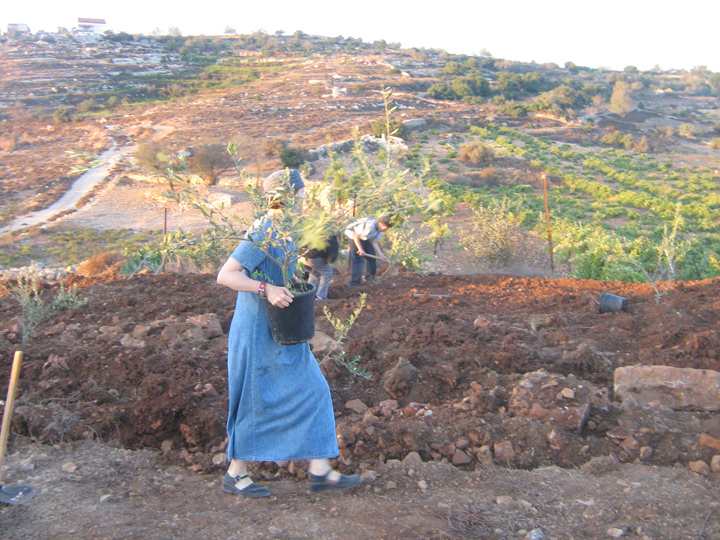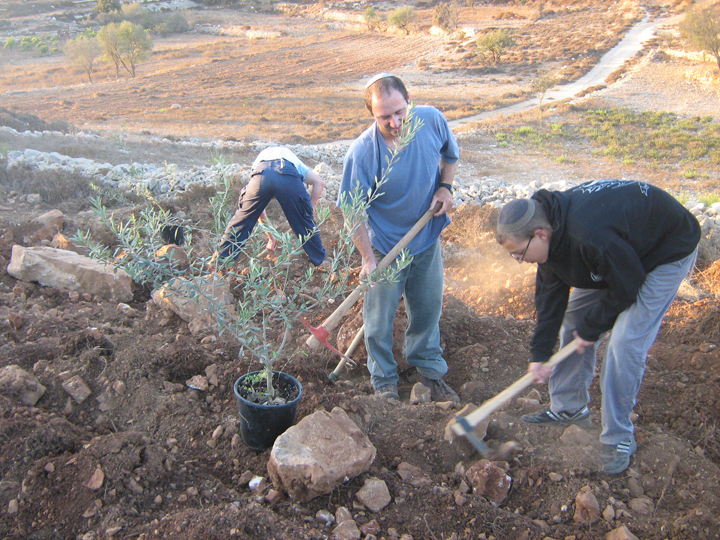
One group hoping to reverse this decline is Women in Green (WIG). Founded in 1993 to protest the Oslo Accords, WIG expanded its activities after the 2005 Gaza withdrawal. Like others in the settlement movement, WIG sees a crisis in a settlement enterprise that, for many, is as much about convenience as about ideology. WIG tries to reintroduce Yedi'at Ha-'arez as a living Zionist principle by bringing Israelis together with their land—a project that began for practical reasons, but which has developed into an ideological underpinning of their work.

WIG's practical concern is an area known as Netzer—an uninhabited, two- kilometer stretch between Elazar and Alon Shvut in the Gush Etzion bloc. Nearly all of Netzer is classified by Israel as "state land." According to WIG, the residents of Alon Shvut and Elazar assumed that Israel would eventually designate the "state land" in Netzer as part of their communities, thereby allowing expansion to accommodate their growing populations.
In late 2009, however, WIG learned that Palestinian farmers had, for several years, been engaged in a campaign of legal seizure of the state land that threatened to block any future Jewish expansion in Netzer. Employing a strangely extant article from the Ottoman Land Code of 1858 granting ownership of land to anyone who farmed it for ten consecutive years, Palestinian farmers had been quietly working to gain ownership of much of the land in Netzer. By the time WIG learned what was happening, some Palestinians had been at the task long enough to obtain legal ownership, and others were well on their way. WIG leaders—many of whom are residents of Gush Etzion—were startled to discover this process, occurring unchecked in their own backyard, could dramatically alter their hopes for the region. WIG believed it a baseline responsibility for Zionists to prevent Jewish land from losing Jewish ownership. Yet, the settlers' failure to recognize Palestinian encroachment into Netzer, in WIG's opinion, put the fate of Netzer, and by extension, the future growth of Gush Etzion and of all settlement, into danger. It not only hindered development plans for a natural corridor for Jewish growth, but it gave Palestinians a blueprint to exploit Jewish apathy to create "facts on the ground" that could undermine settlement expansion anywhere in the West Bank.
When WIG learned of the situation, it investigated and found that most of Netzer's vacant land was, at that point, still state land, so a Palestinian takeover of the strip could, theoretically, be blocked. It also realized, however, that to counter the process of Palestinian land seizures, WIG would have to use the same land code provision and farm the land itself. WIG would plant on state land in Netzer with the intention of planting every open space as soon as possible. In doing this, WIG hoped for one of two equally favorable outcomes: If it farmed land for long enough, the land would eventually be declared private Jewish land or, if WIG activists came into direct conflict with Palestinians over usage rights to a specific plot of land, the army would likely get involved and order that the contested plot be off-limits to all. In which case, its status would remain as state land.
As soon as WIG began its campaign, its volunteers recognized that, to succeed, they would have to devote themselves wholeheartedly to working the land— plowing, planting, and irrigating, day and night. Most volunteers worked regular day jobs, and got calls late at night to start planting a piece of land or to guard a new planting before having to return to work the next morning. As one volunteer explained, the planting work has "changed our lives completely." The work bears close resemblance to homah u-migdal, the grassroots Zionist work of the Yishuv era, in which activists advanced Jewish dominion over pockets of land under the cover of night, and by day guarded their newly created "facts on the ground." But rather than marking new territory with fences or guard towers, this strategy is all about agriculture. New conquests are a field plowed or grapevines planted in darkness. As the group's work has run into direct conflict with Palestinian farmers using the identical strategy, WIG's Netzer activity can best be described as plot-by-plot trench warfare, with each side trying to plant faster than the other.
The following recounting of one week in the summer of 2010 is, according to WIG leadership, a typical illustration of the group's work in Netzer:
On Monday night, a WIG activist noticed that a recently laid pipe had been burned. Assuming Palestinian vandalism, WIG retaliated by expanding their planting into an adjacent plot of still-vacant land. They worked all night, planting hundreds of grapevines. When activists returned the next morning to check the vines, they encountered a group of Palestinians uprooting them. The WIG group confronted the Palestinians, who insisted the plot legally belonged to them. WIG called in the army to mediate. When the soldiers arrived, they notified everyone that the disputed plot was state land, ordering both groups to stop their activities. With the plot's status frozen, WIG considered the matter closed, assuming that it had effectively achieved victory.
The following day, WIG discovered that Palestinians had returned and completely uprooted the grapevines, presumably in preparation for their own planting. WIG decided that if the Palestinians would not abide by the army's decision, neither would it. So, early Thursday morning, WIG volunteers returned with several large trees they intended to plant on the contested plot. However, the police, aware of the plan, were waiting in Netzer to block the group and confiscate the trees. WIG quickly diverted the trucks, temporarily hiding the trees at a nearby kibbutz.
Two nights later, on Saturday, with the matter presumably cooled, WIG returned to plant the trees. Sunday morning, they discovered that Palestinians had uprooted them all. So that night, they returned and planted the trees—deeper this time. Volunteers guarded the trees around the clock for the next three days.
On Thursday morning, the volunteers left. Within an hour, WIG learned that several Palestinians had returned with power saws. WIG called the army, which again declared the spot frozen. After that, the Palestinians did not return, and the battle moved on to another plot.
While WIG works tirelessly to stop loss of state land in Netzer, its larger goal is to counter what it considers the root cause of the Netzer problem—namely, the lost commitment to Yedi'at Ha-'arez , which WIG considers critical to maintaining a strong and healthy Zionism. WIG believes there is a critical gap between an intellectual and an actual appreciation of the land that must be bridged for the prosettlement community to have any chance of eventual victory over the land-for-peace camp. From WIG's perspective, this is best achieved through promoting physical re-engagement with the land. They want Jews planting—feeling dirt with their hands and sweat on their faces, believing this will reawaken people's moribund Zionist impulses, as has happened with their own volunteers.
To this end, WIG engages in outreach and education to encourage Jews to experience planting in Netzer. Though WIG has achieved "victory" over plots of land, it considers its greater success bringing Jews back into communion with the land. For example, WIG has helped less ideologically inclined residents of Elazar and Alon Shvut recognize the importance of land issues, freeing them from what WIG considers an "enclave mentality." As one leader said, residents "used to not look at those hills [in Netzer] at all. . . . We basically taught the people to look beyond their living room . . . to walk the hills, and show their ownership over the land." Additionally, WIG's well- attended summer camp attracts youth from across Israel. WIG admits that it is hard to "take those kids away from . . . Facebook, from everything, and actually make them touch the land, and feel the land and connect to the land." But many have gotten involved, and WIG believes it has engendered passion for the principle of maintaining Jewish sovereignty over all the Land of Israel. WIG also hosts busloads of Israelis who participate in planting. To WIG, this type of reimmersion in land and labor is necessary to revitalize a love of and commitment to the land, which is necessary for the settlement project to survive long term.
WIG sees the settlement project as endangered, principally because Jews have strayed from the Yedi'at Ha-'arez that tied them to the land and helped them succeed in its redemption generations earlier. While it recognizes the practical benefits of working the land, WIG more importantly believes it is only through a reinvigorated Yedi'at Ha-'arez amongst Israeli that the settlement project, and indeed the Zionist dream itself, can be saved.

